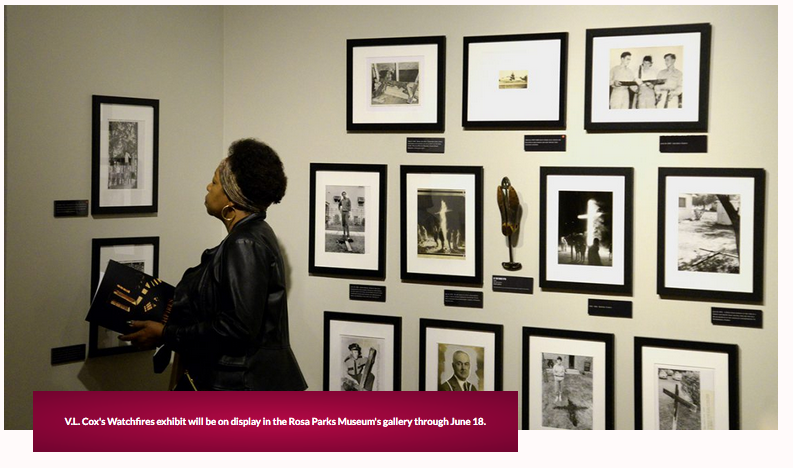V.L. Cox's Watchfires exhibit will be on display in the Rosa Parks Museum's gallery through June 18.
Artist V.L. Cox believes visual arts provide a platform through which to consider serious issues facing the United States, and she hopes her latest exhibit, “Watchfires,” will prompt viewers to think about and discuss those issues.
A reception was held on Thursday night to celebrate the exhibit, which is currently on display at Troy University’s Rosa Parks Museum. The exhibit is available for viewing, free of charge, in the museum’s gallery from 9 a.m. to 5 p.m., Monday through Friday.
“I realized when I did the visuals like I did, using history, that this body of work basically crosses religious and political boundaries with ease when other means fail,” said the Shreveport, LA native who was raised in Arkansas. “We are so used to being at each other’s throats all the time that we don’t slow down long enough to try to talk to each other. I do think there is still an opportunity to talk to people about some serious issues in our country today. The visual arts really open that door to do that.”
A professional artist for more than 30 years, Cox said she chose the name “Watchfires” out a concern about recent events.
“I decided to use Watchfires as the name because I have been very concerned about how things have been going in the world – how, as people, we have really lost our way with each other,” she said. “I moved up here to the Hudson River area in New York, and I didn’t realize that is where the watchfires originated. It was very inspirational to read about how the troops would see those lights in the darkness and be able to find their way home again. It kind of led into where we have gone as a country, where we are today as a country and the things that we have to address before we can move forward in a healthy manner. That’s what I tried to address with this body of work.”
Cox’s door-frame painting of the late John Lewis has become a popular backdrop for visitors’ photos.
In addition to the title piece, the exhibit includes a painting on a door frame of the late Congressman and Civil Rights leader John R. Lewis, a popular backdrop for visitors’ photos.
“He is one of my personal heroes,” Cox said. “I’ve done a door series for over 30 years now, and I had a door frame with me here in New York, and I thought, ‘I’m going to use that to paint one of my heroes.’ That man is one of the bravest men I’ve ever known of in my life. He was a wonderful man.”
Cox was aided in her efforts to make the image more of a mixed media piece by some friends, adding a poignant historical touch to the artwork.
“I wanted to make it more 3-dimensional, a little more mixed media. I really wanted that one to be special,” she said. “I was very happy that a couple of friends were able to get me some soil from the base of the Edmund Pettus Bridge and I was able to lightly paint that on the bottom of his shoes. That is a very special piece to me and one of my favorite door pieces.”
Cox said she is often asked about where she finds the various materials she includes in her artwork.
“To be honest with you, I don’t find them, they seem to find me,” she said. “I have some friends that are antique pickers through the south and they will call me up and say ‘you’re not going to believe what I’ve got.’ They know what I like and they know what I look for. I don’t have some of these ideas in mind until these pieces just kind of present themselves. I’ll see something somewhere and something in my brain goes off – I know exactly what I’m going to do with it when I see it.”
Cox likes to use strong visual elements that have some historical connection in her artwork.
“You can’t claim fake news when you see something that is an actual piece of documented history. Then, when you tell it from your perspective and point of view and what you’re feeling when you find these pieces and make these creations, it is very personal,” she said. “I definitely want it to come from my viewpoints and how I feel about things, and, so far that has resonated very well. The history part in is crucial – it is very important to me – and I will continue to use those pieces in my work as I move forward.”
Cox hopes those who view the Watchfires exhibit will find an opportunity to slow down and think about the art and what it communicates.
“I want it to be very personal to people – I want them to be drawn into it,” she said. “It is going to be personal not only to me, as the artist, but also to them as the viewer. I hope it lets them think about these things and provides the opportunity to clear their heads and remember where we have been before and where we really don’t need to go again. I believe that this body of work and exhibitions like this really let you catch your breath and take it in, and right now it is so important that we do that.”
Tags
Rosa Parks Museum, V.L. Cox, Watchfires
Author
Andy Ellis is the Director of Communications at Troy University.
COPYRIGHT


